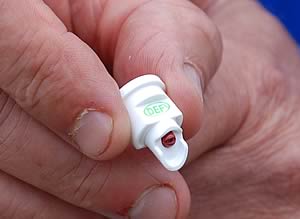 |
|||||||||
|
|||||||||||||||||||
|
|
Specialist Sprayer Nozzle Shown to Boost Early Black-Grass Control 2010-08-24 Using specialist spray nozzles to treat black-grass can boost pre-emergence control up to 10% – even when using a robust herbicide treatment to begin with – new trial results from Syngenta have shown.
The work, which used full-sized farm spraying equipment to apply a herbicide mix of 4 l/ha Defy + 0.4 l/ha lufenacet/diflufenican in winter wheat, showed control was boosted from 88% using conventional flat fan nozzles producing a vertical spray, to some 97.5% when Defy Nozzles –which were developed by Syngenta last season to produce an inclined spray pattern – were used alternating backwards and forwards along the spray boom. In each case, equivalent 03-sized nozzles were used. “With the need to ease the pressure on follow-up post-emergence herbicides for resistance management, growers are clearly looking to improve the level of control achieved from pre-emergence treatments at the start of the season,” says Syngenta application specialist Tom Robinson. “We already know that tank-mixing different pre-emergence herbicides is the first step to improving results – with numerous Syngenta and independent trials showing that moving from 0.6 l/ha of a straight flufenacet/diflufenican treatment to a tank mix of 4 l/ha Defy + 0.4 l/ha flufenacet/diflufenican has given around a 10% improvement in black-grass control on average. “Now, these new results show that moving from a vertical spray to the Defy Nozzles – which produce a spray inclined by 40 degrees to the vertical – can further give up to a 10% improvement in black-grass control, even when this robust tank mixture is used. “Such improvements are important because they reduce the weed population that the follow-up spray has to deal with,” he says.
When launching the Defy Nozzle last autumn, Mr Robinson says it was expected to improve control because the concept of it had been tested. However, this is the first season that the nozzle has been evaluated in a commercial farm situation. The key reason for the improved control, he believes, is because the Nozzle’s spray pattern was developed to produce more even spray coverage around soil surface clods. In particular, testing using water-sensitive paper attached to wooden blocks to simulate clods has shown that alternating Defy Nozzles not only deposit spray droplets on the ‘clods’ themselves, but also on the flat ‘soil’ surface just after them, Mr Robinson adds. “This area might otherwise be shielded from the spray by the clod,” he points out, “because of the forward motion of the sprayer. “Another important feature of Defy Nozzles is that the principles they use have been shown to halve the amount of spray drift. Also, they utilise a narrow fan angle of 83 degrees, rather than the more conventional 110 degrees. This means that, although they give best results at boom heights of 50 cms from the target, they can also be used with modern sprayers which may have a higher minimum boom height of 70 cms. “Besides pre-emergence use, Defy Nozzles have also been tested for other, later spray applications. Growers can fit them for Defy but leave them in for Axial for post-emergence grass weed control in wheat and barley, and for grass weed control in oilseed rape using Fusilade Max. “Overall, what the Defy Nozzle brings is a level of consistency. It’s our recommended nozzle for these treatments for best activity with least drift.” Defy Nozzles are available in sizes of 03, 035 and 04, allowing spraying speeds of 12, 14 and 16 km/h respectively, Mr Robinson adds. Defy Nozzles – key points Overall type: Flat fan with variable pressure design producing inclined spray Designed to not easily block and for reduced drift
|
||||||||||||||||||

|
|
||||||||||||||||||
| home | agri-services | pedigree
pen | news | dairy | beef | machinery property | organisations | site map |
|||||||||||||||||||



